 Iran’s Attack on Israel
Iran’s Attack on Israel
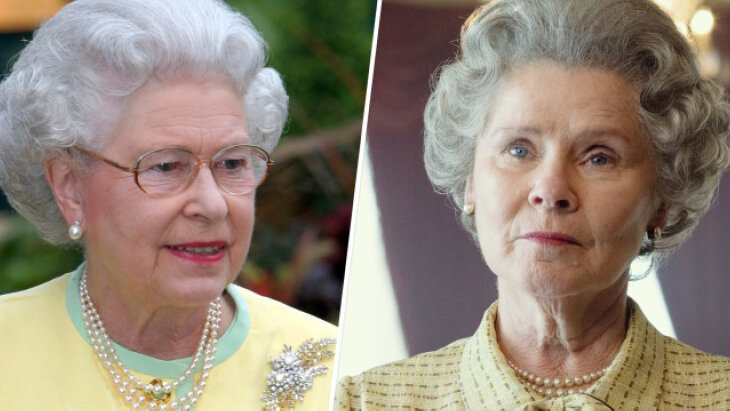

12 min read
British royals have had a long, sometimes tempestuous history with their Jewish subjects.
Here are 12 little-known facts about British royals and the Jews, including some of The Crown’s Jewish connections.
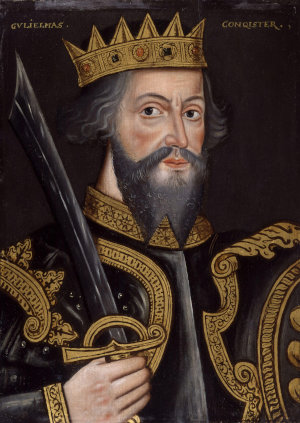 William the Conqueror
William the Conqueror
Britain’s Jewish community likely dates to Roman times, but the earliest records come from the reign of King William I, William the Conqueror, who invaded Britain from France in 1066.
Seeking to fund his new kingdom, King William sent back home for French Jews to settle in his new lands. Since the Catholic Church forbade Christians to engage in money-lending, Jews wound up financing many European royals. Once in England, Jews were allowed to live outside of the feudal system as “wards of the Crown” – property of the royal estate. When local mobs attacked Jews, it was the Crown’s royal representatives – those who manned the King’s castles throughout the land – who often opened their doors to offer shelter to Jews.
Later, under King John, the Crown became the heir to all Jews. Whenever a Jewish businessperson died, his entire estate went to the royal coffers, not his widow and children.
When Richard I (later known as Richard the Lionhearted for his exploits in the Crusades) was crowned in 1189, a large delegation came to his coronation in London. The visiting Jews bore gifts for their new king. As the crowd jostled for a glimpse of their monarch, rumors swept the gathering that King Richard I had ordered England’s Jews to be killed. (No such order had been given.)
 Coronation of Richard I
Coronation of Richard I
The mob turned on the Jews in their midst, attacking them at the king’s gathering. In the words of William of Newburgh, who was present at the coronation,
….a tumult arose. The lawless and furious mob, thinking that the king had commanded it and supported them…by his royal authority, rushed…upon the multitude of Jews who stood watching at the door of the palace. At first they beat them unmercifully with their fists; but soon becoming more enraged, they took sticks and stones. The Jews then fled away; and, in the flight, many were beaten, so that they died, and others were trampled under foot and perished…. (Quoted in Expulsion: England’s Jewish Solution by Richard Huscroft. Tempus: 2006)
Pogroms later broke out across England, as Christian mobs attacked Jews in the towns of Lynn, Norwich, Stamford, Lincoln, Colchester, Thetford, Ospringe, Bury St. Edmunds and York.
With rising antisemitism in England, King Edward I, who was a devout Catholic, decided to amend the conditions under which the Crown’s Jews were allowed to live in England. In 1275, he banned the practice of money-lending among Jews. He also decreed that all of England’s Jews had to wear a yellow badge on their outer clothes, depicting two stone tablets representing the Ten Commandments.
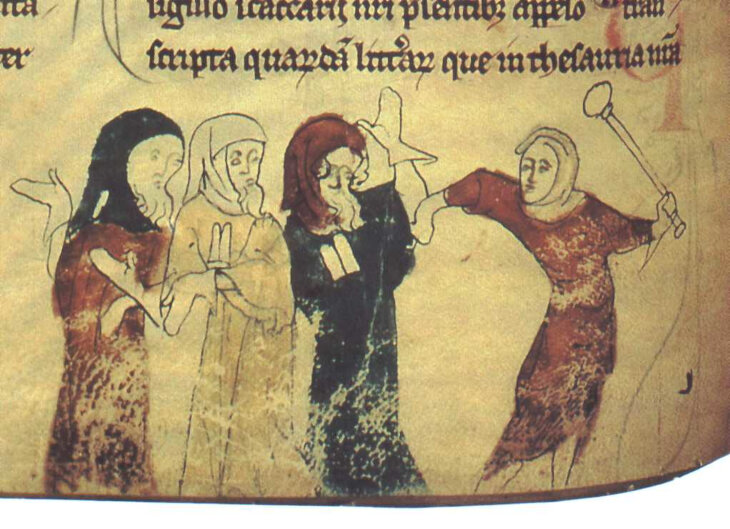 An image of Jews being beaten from a thirteenth-century English manuscript. The figures in blue and yellow are wearing a badge in the shape of two tablets, identifying them as Jews.
An image of Jews being beaten from a thirteenth-century English manuscript. The figures in blue and yellow are wearing a badge in the shape of two tablets, identifying them as Jews.
His dissatisfaction with “his” Jews continued to grow, until King Edward ran up against an ultimatum given to him by England’s feudal lords in Parliament. By 1290, the British Crown was largely broke. King Edward requested a one-time tax of £100,000 (a huge sum - this was the largest tax of the Middle Ages in Britain). Parliament agreed on one condition: that King Edward would ban Jews from living in the country. The king agreed, and England became the first European nation to forbid Jews from living or visiting there.
The deadline of November 1, 1290 was set for the Jews to leave. Thousands of Jews made their ways to boats to take them away from Britain. In many cases, unscrupulous sea captains killed their Jewish passengers, stealing their money and possessions for themselves. Jews wouldn’t return to Britain for hundreds of years.
Queen Elizabeth I, who ruled from 1558 to 1603, wanted the very best physician as her own private doctor. That meant hiring Roderigo Lopez, a Portuguese-born scientist who worked at St. Bartholomew’s Hospital in London and was widely renowned as a caring and capable physician. Dr. Lopez took care of the queen and gained her trust – but in the process he aroused the jealousy and hatred of some of the queen’s advisors. One of Dr. Lopez’s former patients, the Earl of Essex, resented his influence over the queen, and became obsessed with ruining the foreign-born doctor.
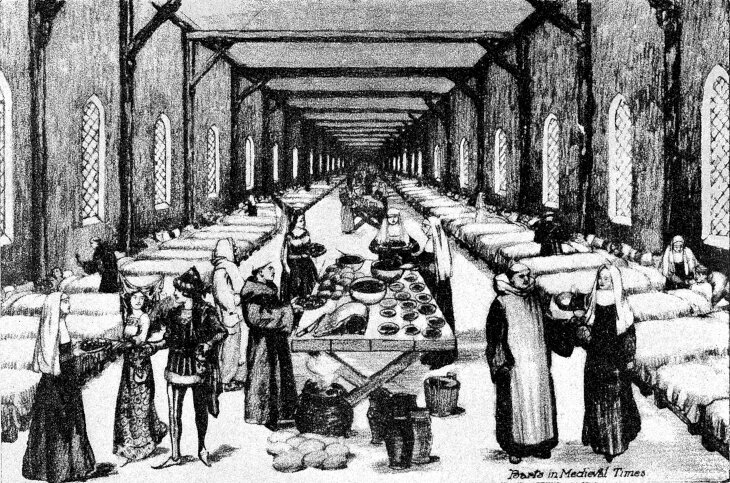 St. Bartholomew's Hospital
St. Bartholomew's Hospital
It wasn’t difficult for the earl to find a way. Dr. Lopez pretended to be a devout Christian, but it seems he was actually a practicing Jew. His father Antonio Lopez was once a physician to King John III of Portugal, and was compelled to convert to Christianity under pain of death. The Lopez family maintained their Jewish lifestyle in secret. Roderigo Lopez moved to England in 1559 after being accused of being a secret Jew in Portugal.
After uncovering Dr. Lopez’s Jewish identity, the Earl of Essex accused him – with no evidence – of plotting to poison Queen Elizabeth I. After resisting these baseless claims, eventually Queen Elizabeth I began to doubt her physician. Dr. Lopez was put on trial, found guilty, and publicly executed in front of a jeering crowd in 1594.
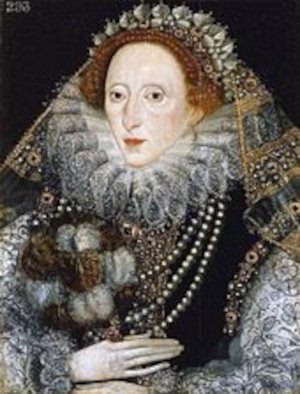 Queen Elizabeth 1
Queen Elizabeth 1
Dr. Lopez’s trial and execution inspired Robert Marlowe’s antisemitic play The Jew of Malta and is speculated to have inspired William Shakespeare’s play The Merchant of Venice as well.
The bloodiest war fought on English soil took place in the 1640s between royalist supporters of King Charles I and the “Parliamentarians” who backed Oliver Cromwell. Cromwell accused the king of treason, and King Charles I was eventually executed in 1649. Cromwell became the “Lord Protector” of the Republican Commonwealth of England, Scotland and Ireland, and Britain was governed as a republic – without a monarch – for the next ten years. A dour Christian fundamentalist, Cromwell was a brutal leader. He’s commonly credited with reversing King Edward I’s decree and inviting Jews to settle in England once again.
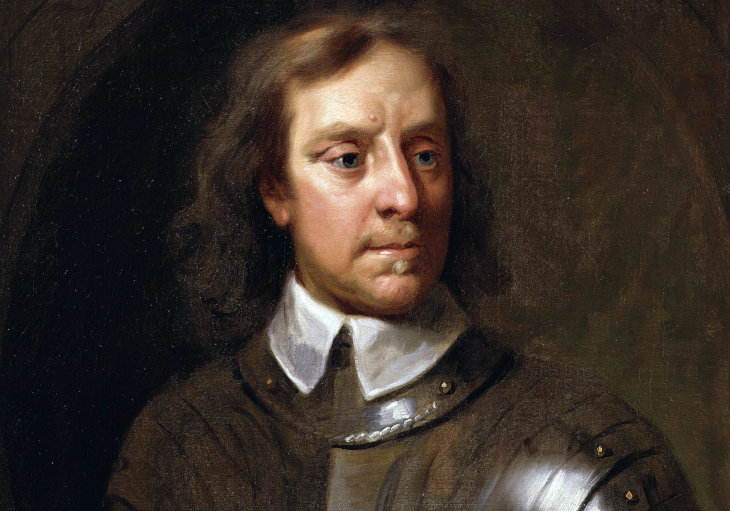 Oliver Cromwell, Portrait by Samuel Cooper, 1656
Oliver Cromwell, Portrait by Samuel Cooper, 1656
The reality is somewhat more complex. The Dutch Jewish leader Menasseh ben Israel petitioned Cromwell to readmit Jews to Britain in 1655. A few years later, a community of secret Jews in London asked Cromwell to allow them to worship openly. Cromwell never openly consented to Jews resettling in Britain, but he didn’t crack down on the increasingly public Jewish communities that began to spring up during his reign. By the later 1650s, a small community of Jews – including several families who’d moved from the Netherlands – once again called Britain home.
Cromwell died in 1658, and in 1660 Britain once again became a monarchy when King Charles II returned from exile in Europe.
Queen Victoria, Britain’s second-longest reigning monarch (after Queen Elizabeth II) was the first British monarch to break with tradition and bestow an aristocratic title on a Jew, knighting the great Jewish philanthropist Moses Montefiore in 1837.
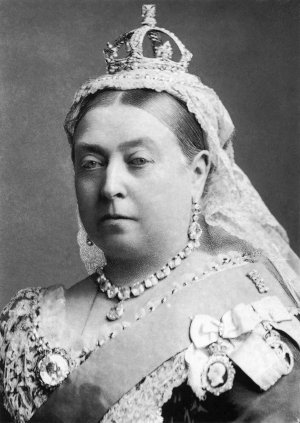 Queen Victoria
Queen Victoria
When some of her advisors objected to giving such an honor to a Jew, Queen Victoria brooked no criticism: “I was very glad I was the first to do what I think quite right, and as it should be,” the queen said. (Quoted in Victoria The Queen: An Intimate Biography of the Woman Who Ruled and Empire by Julia Baird. Random House: 2016)
The late Duke of Edinburgh – depicted by Jonathan Price in Season 5 of The Crown – was born into the Greek royal family in 1921. His father was deposed the following year, and Phillip lived in locations around Europe. He finally found a home when he was 12 and sent to boarding school at a groundbreaking German school in Germany known as Schule Schloss. The headmaster was an eccentric Jewish educator named Kurt Hahn, who encouraged boys to spend lots of times outdoors and whose motto was “There is more in you than you think.”
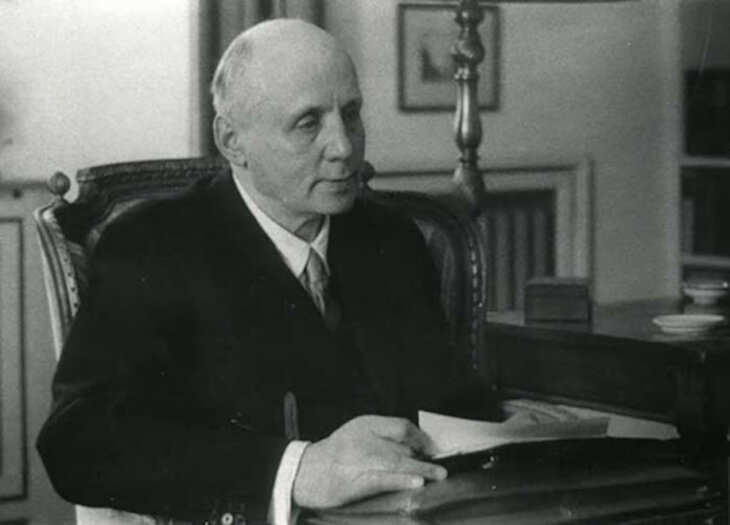 Kurt Hahn
Kurt Hahn
With the rise in Nazism, Headmaster Hahn found himself in terrible danger. A vocal opponent of Hitler, Hahn was arrested and released on condition that he leave the country. He moved to Scotland, where he founded Gordounstoun, a new school with a similar ethos to Schule Schloss. It soon became a sought-after boarding school attended by aristocrats and royals. Prince Philip moved to Scotland to attend Gordounstoun and the lessons he learned there influenced him for the rest of his life.
Later, Hahn helped the prince set up his Duke of Edinburgh’s Award program, which emphasized Hahn’s values of sportsmanship and community service.
While Prince Phillip attended school in Scotland, his parents’ marriage broke up. Prince Phillip’s mother, Princess Alice of Battenberg, occupied the family apartment in Athens. Though her four daughters all married high-ranking Nazis, Princess Alice risked her life to resist the Nazis. She hid her close friends, the Cohen family, in her apartment building during the Holocaust. On one occasion, Princess Alice was even brought in for questioning by the Gestapo, but she refused to turn in the Cohens, who survived the war.
 Princess Alice and Prince Phillip
Princess Alice and Prince Phillip
In 1994, Princess Alice was named Righteous Among the Nations by Yad Vashem in Jerusalem, an honor bestowed to righteous Gentiles who risked their lives to save Jews during the Holocaust. She is buried in Jerusalem’s Mount Zion.
When King Charles III – played by Dominic West in the current season of The Crown – was born in 1948, his mother Queen Elizabeth II knew exactly where to turn to find a trusted professional to circumcise her new son: the leading Jewish mohel (ritual circumciser) in London at the time, Rabbi Jacob Snowman.
It’s thought that members of Britain’s royal family had been employing Jewish mohels to circumcise their offspring ever since King George I brought the tradition of aristocrats hiring Jewish circumcisers to Britain in the 1700s. When it came to the next generation, however, Princess Diana - whose son Prince William will one day be king - refused to carry on the tradition.

Some of the late Princess Diana’s most iconic style moments were enabled by Jewish clothing designers she favored. The Crown’s Elizabeth Debicki captures much of the late princess’ stunning looks; many of these were created by up-and-coming Jewish fashion designers. Jewish designer Elizabeth Emanuel created the iconic dress that Diana wore to her 1981 wedding. Emanuel also designed the black taffeta dress that Diana wore for her first royal engagement later that year. Princess Diana later recalled that her then husband, the current King Charles III, was aghast at her groundbreaking decision to wear black - the color of mourning - for a royal event.
David Sassoon, another British Jewish designer Princess Diana favored, later recalled, “When I first made dresses for her, she was 19 years old and liked to wear pretty and romantic dresses. But over the years, her taste changed and she became more glamorous and sophisticated.”
As Princess Diana’s marriage crumbled, she turned to Anthony Julius, a Jewish lawyer who’d once helped her in a legal case after she’d been secretly photographed working out at a London gym without her consent. Julius later recalled that the only time in his long legal career he’d experienced antisemitic attacks was when he represented the princess.
“Several newspapers and magazines published profiles of me, in the main composed out of clichés,” Julius later wrote. “As a Jew I was an ‘outsider’, not ‘Establishment’...I also started receiving odd letters during this time…some were antisemitic.”
 Anthony Julius
Anthony Julius
The British newspaper Telegraph impugned Julius’ integrity, writing: “Anthony ‘Genius’ Julius(‘s)...background could not be further from the upper-class world inhabited by his opposite number. He is a Jewish intellectual and Labour supporter, and less likely to feel restrained by considerations of fair play. ‘I’d be very worried if I were the Royal Family,’ says a Cambridge don who taught him. ‘He’ll get lots of money out of them.’” Julius was so struck by the anti-Jewish sentiment leveled at him he later wrote a book about antisemitism, Trials of the Diaspora: A History of Anti-Semitism in England (Oxford University Press: 2010), from which the above quotes are taken.
The stirring theme music at the beginning of each episode of The Crown was composed by distinguished German composer Hans Zimmer. Zimmer, who’s written the music for well over a hundred movies, including The Lion King, Gladiator, Pirates of the Caribbean, The Prince of Egypt and The Dark Knight, grew up hiding his Jewishness, instructed not to mention his heritage by his Holocaust survivor parents.
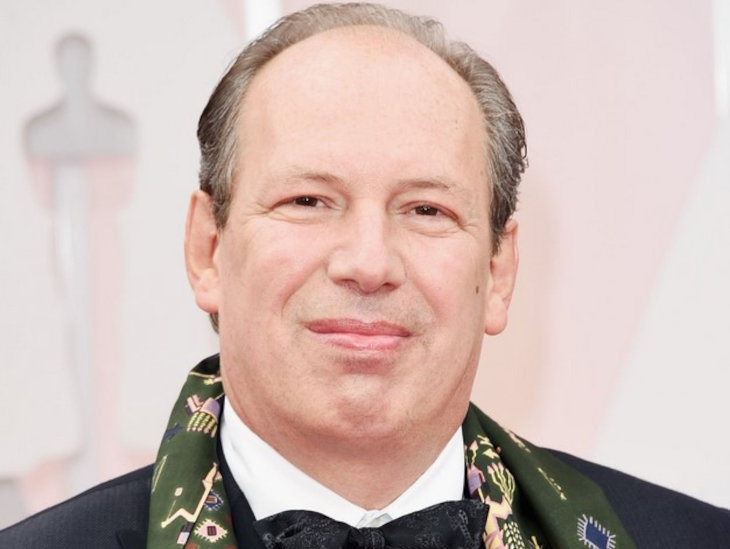 Hans Zimmer
Hans Zimmer
That changed in 1999, when Zimmer was invited to speak at the Berlin Film Festival about his work on The Last Days, an Academy Award-winning Holocaust documentary that was shown there. A reporter asked what made him decide to work on a Holocaust film. “I said, ‘Actually, I have to confess, I have a rather complicated relationship with my country because I’m Jewish.’ And as soon as I said this” all the reporters and photographers began focusing on him, he later recalled.
“I started having a major anxiety attack…a major meltdown… I couldn’t wait for the press conference to end. And as soon as it finished, I got on the phone to my mom and I said, ‘Mom, I did something really terrible. I told them. I let everybody know who we are.’ I felt like I put her in danger. That this was the deep, dark secret we should never speak about. There was a long pause at the other end and then she said, ‘I’m very proud of you.’ That is the only time she ever said that to me.”
Since then, the Zimmer family has proudly embraced their Jewish identity.
